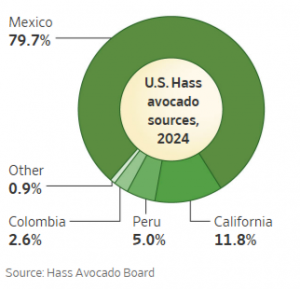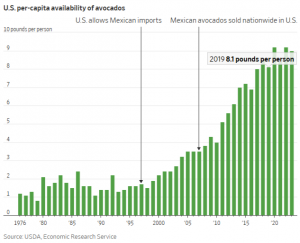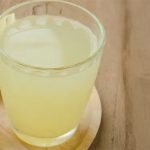By Ben Cohen March 7, 2025 in Wall Street Journal
Every now and then, you come across a product that makes you question how you could have possibly existed without it.
It’s happened with many of the dazzling creations that have swept the nation in the 21st century, like Facebook and the iPhone—and the avocado.
As it turns out, the history of avocados conquering America is as rich and slightly nutty as the avocado itself.
These days, the average American devours about 9 pounds of avocados a year. If that sounds like a lot of avocados, that’s because it is. In the 1970s, it was less than 1 pound. In the 1990s, it was still less than 2 pounds. Even since 2000, America’s national avocado consumption has quadrupled.
And the reason avocados have exploded in the U.S. is that most of them are no longer grown in the U.S.

We have developed such a voracious appetite for this versatile fruit that the U.S. now annually brings in nearly 3 billion pounds of avocados. In fact, 90% of the avocados that Americans eat are imported—and close to 90% of those imports come from Mexico.
It’s hard to remember a time when their availability was so limited that avocados were more like a luxury item. Except that time wasn’t very long ago.
They were only allowed into the country from Mexico in 1997. They weren’t accessible across the country until 2007. Now they are beloved everywhere in America—and not just because they are healthy and delicious.
“The success of the avocado industry is rooted in our trade relationship with Mexico,” said David Ortega, a Michigan State University professor of food economics and policy.
But recently, this fruit that owes its success to free trade has found itself on the front lines of a trade war.
This past week, President Trump slapped Mexican imports with 25% tariffs and left companies in the avocado business scrambling to decide whether to eat the costs—or feed them to consumers. Before they could make their decisions, the White House swerved and suddenly delayed the tariffs for a month, which means they’ll have to navigate the uncertainty all over again soon.
But no matter what happens next, there are two things that probably won’t change about the avocado economy.
The first is that U.S. companies will keep importing from Mexico because that’s the only way they can meet the year-round demand. The chances of American farmers making enough avocados on their own are roughly the same as their chances of making avocados neon pink.
The second is that U.S. consumers will keep buying avocados.
I know I will. This is where I have to reveal my personal biases and admit that I happen to love avocados. I love them in sandwiches, salads and smoothies. I love them in sushi rolls and burrito bowls. I bet I would love Tom Brady’s famous avocado ice cream, too.
As much as I love avocados now, I don’t remember having avocado-related feelings of any kind as a child during the 1990s in New Jersey. My toddler knew how avocados tasted before she knew how to walk. I didn’t know much about them until I was an adult. I must have had guacamole, but I can’t recall ordering avocado in a restaurant or wiggling open a ripe avocado and having the satisfaction of seeing that exquisite green.
And there’s a perfectly logical explanation for why I didn’t grow up with avocados in my life.
Until recently, most Americans didn’t.

Ben Faber is one of the lucky exceptions. As a soils, water and subtropical crops farm adviser at the University of California’s Cooperative Extension, he has been studying avocados since the 1980s—and he’s seen the industry evolve in ways that he never could have predicted.
“Nobody in Wisconsin even knew how to spell avocado,” he said. “And now people in Wisconsin want their avocado toast.”
So how did that happen?
It’s a tale of economics, geopolitics, marketing, government legislation, scientific advances, dietary trends—and weevils.
The U.S. blocked Mexican avocados from entering the country in 1914, when seed weevils were discovered in Mexico’s orchards. America’s plant-health officials decided the most effective way to stop pests from migrating north of the border was to ban Mexican avocados outright. And that policy remained in place for nearly a century.
For most of that time, avocados were difficult to find outside of California. But inside California, Mary Lu Arpaia didn’t even have to leave home to find them. She grew up with two avocado trees in her suburban backyard.
Now a professor at the University of California, Riverside, she started her career there in 1983, when unripe avocados sold in grocery stores felt like baseballs. But it was around that time when avocado researchers became obsessed with an idea that would revolutionize their industry: ripening.
To increase awareness, demand and sales, avocado growers realized they had to give consumers a product they actually wanted, something just firm enough to buy in the morning and eat for dinner that night.
Basically, avocados had to be more like bananas.
It was a simple insight that would change the industry forever. Through a series of experiments, researchers figured out how to improve ventilation on pallets of ripening avocados.
As soon as Americans were able to grab softer avocados in a grocery store, they began filling their shopping carts with them. These days, you can feel a bunch of plump avocados and pick the ones that are immediately ready to be smashed into guacamole. But that’s only possible because of all that ripening progress.
“It laid the foundation for this avocado renaissance,” Arpaia said.

The next twist in the national avocado saga came when the U.S. began sourcing avocados elsewhere. At first, the supply came from a different hemisphere altogether because countries like Chile were able to provide avocados in the winter.
But it was only a matter of time before the world’s largest producer of avocados was able to crack the U.S. market.
Growing avocados requires precisely the right combination of geography, altitude, climate, sunlight, rain, irrigation, topography and soil quality. One of the few places with ideal conditions for avocado production is the Mexican state of Michoacán. What Michigan is for cars, Michoacán is for los aguacates.
This fruit from Mexico was finally permitted to cross the border in the 1990s, when the U.S. relaxed import rules after signing the North American Free Trade Agreement, which is easily the most consequential treaty in the history of avocados.
But it still took 15 years after Nafta was signed for avocados to make their way from Mexico to all of the U.S. The first wave of imports brought them to Northeast and Midwest states in 1997, and the first time avocados grown in Mexico were finally permitted everywhere in America was 2007—which means avocados went nationwide the same year as iPhones.
And almost every avocado you buy today helps sell more avocados.
That’s because of a decision made in Washington, D.C., long before this past week’s tariffs drama.
At the behest of California avocado growers, Congress established a federal program in the early 2000s that collects a few pennies for every pound of fresh Hass avocados sold in the U.S., whether they were grown domestically or imported.
That modest fee of 2.5 cents funded marketing campaigns that promoted health benefits of avocados and rebranded the food as a superfood—similar to the way California dairy processors paid for the classic “Got Milk?” ads.
Now that we’ve all got avocados, the organization’s goal is to make them the most popular and desirable fruit in the U.S.
And to make sure we never, ever have to go back to life before avocados.
Source: Wall Street Journal








